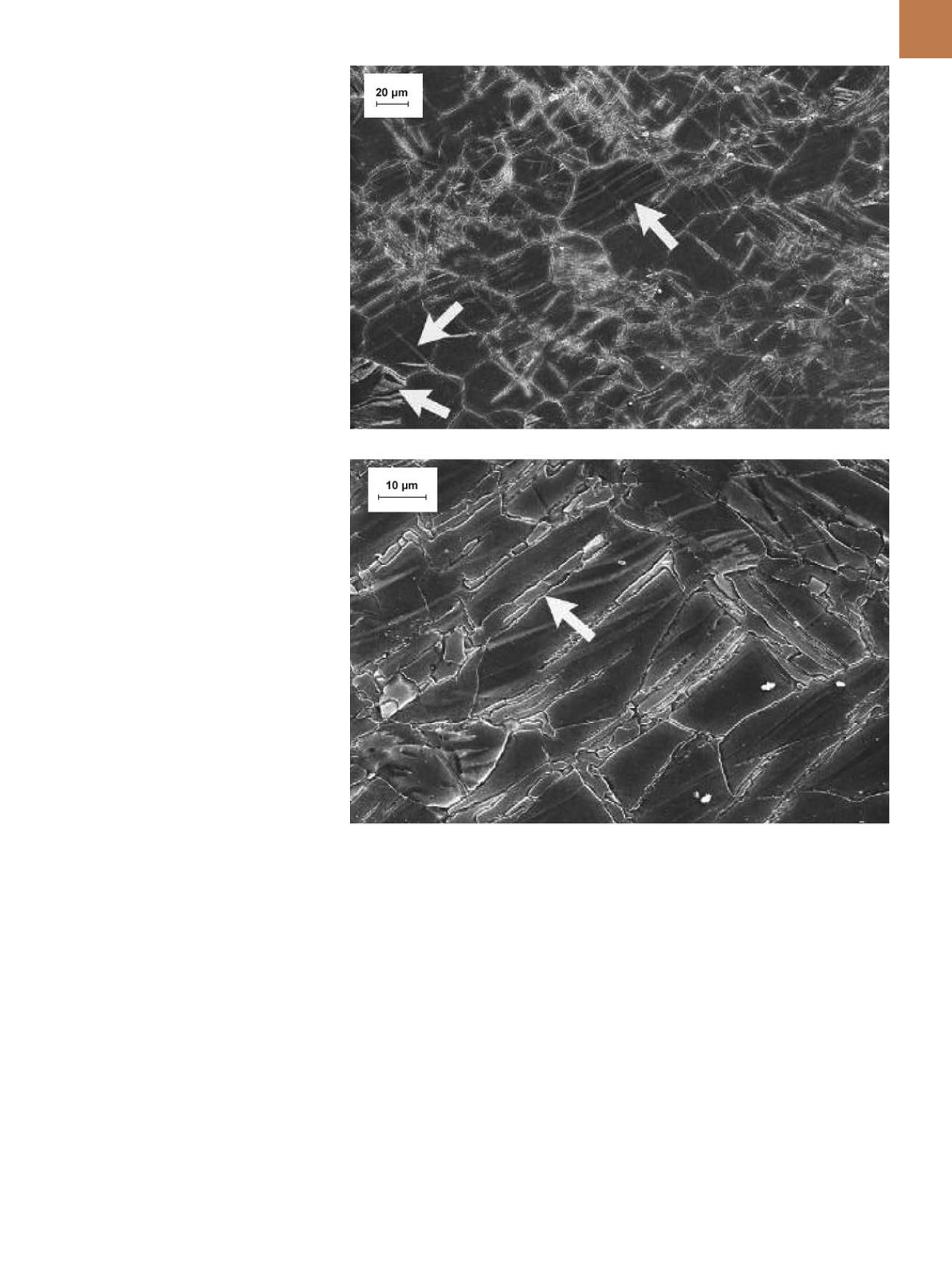

A D V A N C E D
M A T E R I A L S
&
P R O C E S S E S |
A P R I L
2 0 1 5
2 9
STATIC RECRYSTALLIZATION
Recrystallization is a thermally
activated process during which new
strain-free grains replace the existing
deformed microstructure by the forma-
tion and migration of high angle grain
boundaries (HAGBs)
[17,18]
. As previously
stated, magnesium suffers from incom-
plete recrystallization as well as reten-
tion of deformation texture (basal tex-
ture). The latter is detrimental to sheet
formability, thus restricting broad ap-
plicability of magnesium alloys
[19]
. Sev-
eral factors contribute to the retention
of deformation texture in annealed ma-
terial. These include limited nucleation
sites that allow nucleation of off-basal
orientations, absence of recrystalliza-
tion within significant portions of the
material, and grain boundary bulging.
Plastic deformation of magne-
sium takes place by the activation of
many slip and twin systems. Among dif-
ferent slip systems, basal slip is consid-
ered to be the easiest mode with CRSS
~0.5 MPa
[20]
. Slip on non-basal slip sys-
tems such as prismatic <a>, pyramidal
<a>, and pyramidal <c+a> are also ob-
served
[2]
. However, the CRSS required
to initiate slip on these systems is very
high (e.g., CRSS of prism
∼
44 MPa; py-
ramidal <c+a>
∼
40 MPa
[20]
). Besides slip,
the following twin modes are frequent-
ly observed in magnesium:
Extension
twinning,
activates when <c> axis is
under tension;
contraction twinning,
activates when <c> axis is under com-
pression; and
double twinning,
formed
by contraction twinning followed by
extension twinning within the contrac-
tion twin
[21]
. The extension twinning re-
orients the grain by approximately 86°,
while contraction twinning and double
twins make a 56° and 36° angle with the
matrix, respectively.
Many scholars
[9,10,14,21]
emphasize
the significance of deformation twin-
ning in the recrystallization of magne-
siumalloys.TheworkofLevinsonetal.
[14]
illustrates the role of extension twin-
ning. They deformed AZ31 alloy sam-
ples (compressive strain = 0.05) in the
orientation that favors extension twin-
ning and then subsequently annealed
(T = 275°C). Results suggest that only
33% of the material was recrystallized
even after prolonged annealing. The
mechanism of recrystallization was re-
ported to be strain induced boundary
migration (SIBM) or grain boundary
bulging. Nonetheless, this suggests
that extension twinning plays a small
role in nucleation of strain-free grains
and subsequently retards the recrystal-
lization rate. In another study
[9]
, it is re-
ported that extension twinning has very
mobile twin boundaries; thus they opt
for thickening rather than creating the
further strain localization necessary for
recrystallization.
Alternatively, contraction and
double twins are very thin (Fig. 2a)
[21]
.
These are mostly formed at the later
stage of deformation (i.e.,
ε
> 5%) and
often act as a potent site for recrystal-
lization nucleation (Fig. 2b). Formation
of new recrystallized grains at contrac-
tion twins also appears in Fig. 2b. In
some instances, it is attributed to the
transformation of <a> type of glissile
dislocations into sessile dislocations
due to twinning
[22]
. This leads to ac-
cumulation of dislocations within the
twinned regions and thus increases the
Fig. 2 —
Microstructures of AZ31 magnesium alloy rolled at 100°C and then annealed at 280°C
for 10 s demonstrating (a) the presence of contraction twins and (b) nucleation at contraction
twins
[9]
.
(a)
(b)


















